Posted: Thu Nov 02, 2017 9:59 am
Alberto Clemente hails from Sunny Spain and for some reason, probably linked to my technical incompetence, he's not able to post directly to The Brew Cabin, so he's asked me to post this on his behalf....
Hi Tony,
first of all, congratulations for your website, it's the best that I have found on the topic. I'm pretty new in the paving world, just started to work for a small, familiar manufacturer and it has really allowed me to catch up. Here is something I hope you can help me with:
We have received some reports about dark stains on randomly located concrete slabs in urban floors, and I'm trying to get to the cause. However, I suspect there are different types of stains, with different origins. I'll try to describe both of them.
In this case, the problem is located next to a water font. There is a blackish shade on every slab inside the water splash radius, including the red concrete bikeway (picture 1). This makes me think there is a superficial-nature stain, probably from fungi or algae, or due to a more intense walking in that area. I have cleaned the surface with a metallic brush and the stain kind of fades away, and also bleach seems to partially take it away.
On the other hand, other type of stains have appeared a little further from the font, downhill, which suggests draining water above or beneath the slabs is involved (picture 2). These stains have a rather different look, with watermarks similar to those in the efflorescence cases, so I would think of either a pigment migration ascending through the slab due to capillarity and surface evaporation. I've checked that black and red pigments have a much bigger migration capabilities due to their smaller particle size, so in some cases these pigments can be expected to appear on the surface. Also, some impurities (iron?) present in the mortar or sand bed, or in the back of the slab may be involved.
In some other places (pictures 3 and 4), similarly looking stains have appeared, with no water source to be seen (although moisture could very well be hidden underneath). Also I’ve noticed these stains seem to be more common in areas covered under a roof (pictures 5 and 6), maybe meaning that the evaporation rate is important as those areas are more shadowy and would dry more slowly.
I’ve seen these types of stains in a lot of places, in slabs made by different manufactures, but surprisingly haven’t read a lot about them on the net. Have you ever seen this problems before? Can you give me a hint on was going on? Also, if you can point me any further reading on this issues I would also appreciate it (no problem with chemistry jargon).
Thanks a lot for your time. As I said, best website on the topic. Keep the good work up!
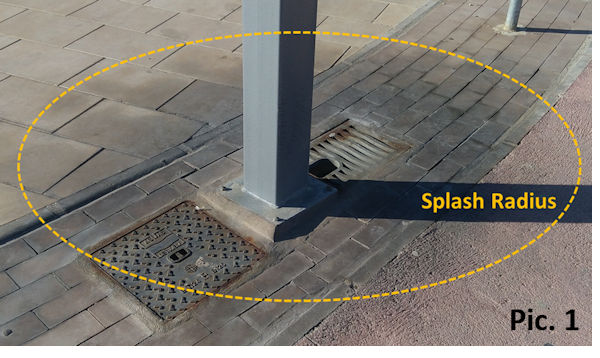

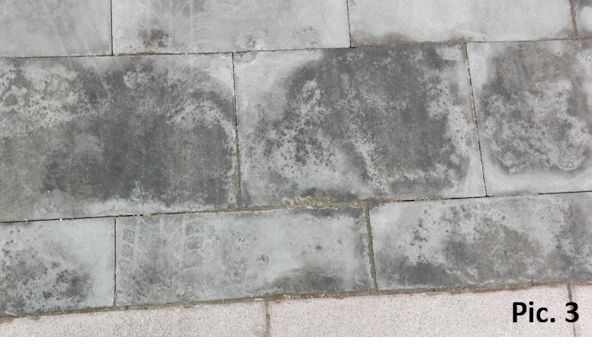
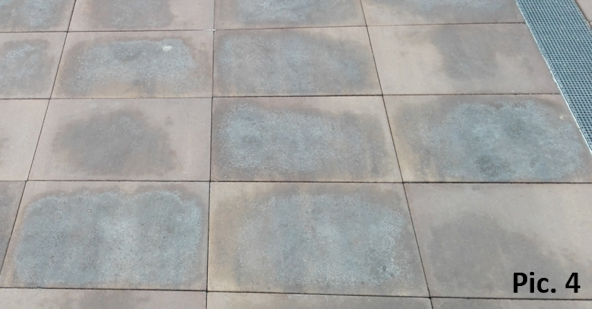
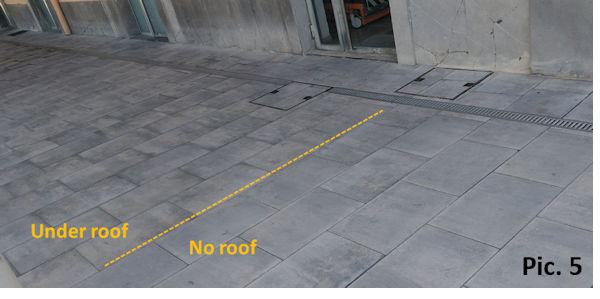
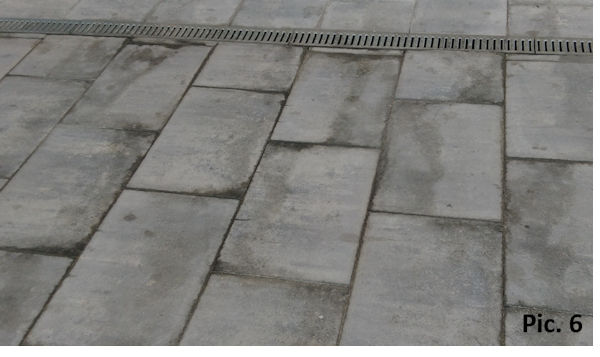
Hi Tony,
first of all, congratulations for your website, it's the best that I have found on the topic. I'm pretty new in the paving world, just started to work for a small, familiar manufacturer and it has really allowed me to catch up. Here is something I hope you can help me with:
We have received some reports about dark stains on randomly located concrete slabs in urban floors, and I'm trying to get to the cause. However, I suspect there are different types of stains, with different origins. I'll try to describe both of them.
In this case, the problem is located next to a water font. There is a blackish shade on every slab inside the water splash radius, including the red concrete bikeway (picture 1). This makes me think there is a superficial-nature stain, probably from fungi or algae, or due to a more intense walking in that area. I have cleaned the surface with a metallic brush and the stain kind of fades away, and also bleach seems to partially take it away.
On the other hand, other type of stains have appeared a little further from the font, downhill, which suggests draining water above or beneath the slabs is involved (picture 2). These stains have a rather different look, with watermarks similar to those in the efflorescence cases, so I would think of either a pigment migration ascending through the slab due to capillarity and surface evaporation. I've checked that black and red pigments have a much bigger migration capabilities due to their smaller particle size, so in some cases these pigments can be expected to appear on the surface. Also, some impurities (iron?) present in the mortar or sand bed, or in the back of the slab may be involved.
In some other places (pictures 3 and 4), similarly looking stains have appeared, with no water source to be seen (although moisture could very well be hidden underneath). Also I’ve noticed these stains seem to be more common in areas covered under a roof (pictures 5 and 6), maybe meaning that the evaporation rate is important as those areas are more shadowy and would dry more slowly.
I’ve seen these types of stains in a lot of places, in slabs made by different manufactures, but surprisingly haven’t read a lot about them on the net. Have you ever seen this problems before? Can you give me a hint on was going on? Also, if you can point me any further reading on this issues I would also appreciate it (no problem with chemistry jargon).
Thanks a lot for your time. As I said, best website on the topic. Keep the good work up!





